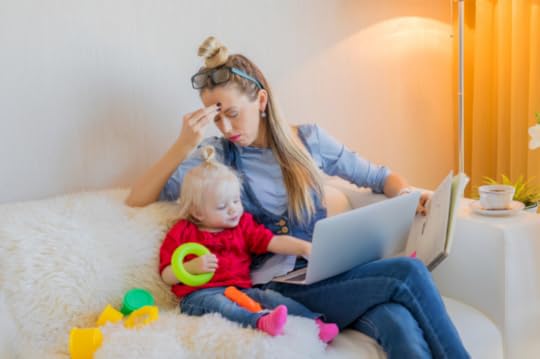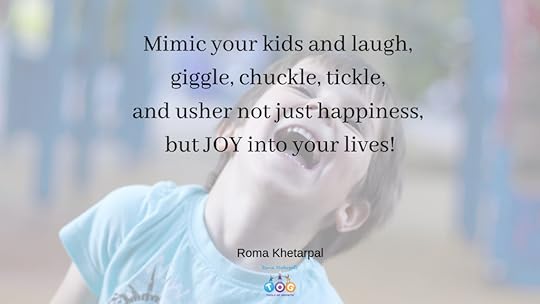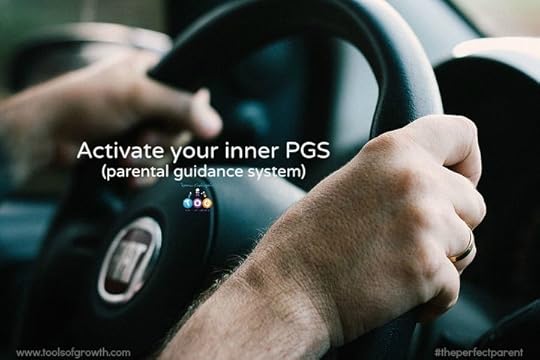Roma Khetarpal's Blog, page 8
May 28, 2019
Parenting Styles: Are You Encouraging Growth or Hindering It?

Tyler and Nathan got into trouble at school. Being 14-years old and living in a body of fired hormones, it was bound to happen. Impulsive, impatient and impolite, both boys were imp-ing for trouble! They had it coming! All in one month, together, they had:
1. Hidden Careen’s backpack on the football field.
2. Snuck into the girls’ bathroom and planted a time-released cockroach jar explosion.
3. Reprogrammed the school bell 30 minutes ahead.
Surprise! Life catches up with you. They were busted and ended up in the Head Master’s office where they had another surprise waiting for them: their parents. Both were delivered their sentences of a three-day suspension. Wow! A reward of no school! But here’s what the home scene looked like:
TYLER:
On arrival at his home after a silent car ride, his father took the lead and asked:
“What prompted this behavior?”
“Just silly fun,” responded Tyler with his head hanging.
“Did you not realize where this would eventually lead to or did you just assume you’d get away with it?” nudged Dad firmly, yet calmly.
”I don’t know, I didn’t think about it.” replied Tyler, still avoiding eye contact.
“I know your brain is developed enough to know what happens when you do things without thinking. But I guess it’s up to you whether you choose to use it or not,” his father responded.
“I’m sorry, Dad. Are you also going to punish me?” Tyler asked in a low toned voice with his head still hanging and fingers interlocked.
“You’re going to type up a ten-page research paper on the two hemispheres of the brain and identify which one you used and why, and which one you should have used and why. Your verbal presentation of it will be due on Saturday morning right after breakfast. It’s Wednesday and since you’ll be home for the rest of the week, you have plenty of time.”
NATHAN:
In the car, both parents took turns screaming at Nathan:
“We were so embarrassed,” started the mom. “How dare you do stupid things like that and make all of us look like idiots!”
“What the &^*% were you thinking?” joined in the father. “I’m sick and tired of your behavior. In my day, a good beating could have fixed this.”
“I’m so sick of you guys talking down to me,” Nathan lashed back.
“No, we’re so sick of you behaving like a fool,” said the dad, “That’s it! You’re grounded for a month. No friends, no movies, no hanging out. To school and back you’ll go. That’s it! Have I made myself clear?”
“Yes,” muttered Nathan, mad and sad.
These are two completely different parenting styles. One encouraging intellectual resolution by using common sense reasoning, logic, and understanding as a “punishment,” contributing fully toward the teenager’s growth. Whereas the other left behind yet another trail of unresolved and senseless emotions hindering growth.
Through logic and reasoning, parents can teach children to understand themselves. And understanding one’s self is the most important step toward independence. Is that not what we all want for our children? To be independent and responsible?
“A man who does not think for himself does not think at all.” — Oscar Wilde.
Reasoning teaches our children to do just that: think for themselves. Reasoning helps children learn from their mistakes and grow. Now that’s a gift every parent should give their child every opportunity they get. Don’t you think?
The post Parenting Styles: Are You Encouraging Growth or Hindering It? appeared first on Tools of Growth.
May 12, 2019
Motherly Love – A Healing Journey

It was just 48 hours before my daughter’s bridal shower, and I was unable to walk straight. Severe back pain had brought the madness of wedding prep to a screeching halt. I had been playing Mother of the Bride with patience, dedication, and pride for the last six months, and my daughter and I had literally worked 16 hours a day, juggling our day jobs and wedding planning, to put together a week-long traditional Indian wedding
It had been fun and work intertwined, and we were definitely in the homestretch. But now, 48 hours before the first event, I couldn’t even get out of bed. I sent an SOS to a dear friend—a renowned neurologist—and after a visit to her office, I ended up with a cocktail of meds that got me through the bridal shower. I couldn’t wear the dress or the shoes I had planned on, but I put on a good face and made it through the day.
I’m a pretty upbeat and optimistic person—after all, I teach self-empowerment—so I was hoping that within the promised 72 hours, I would be healed. But as the muscle pain eased, nerve pain acted up. Then came an MRI and more meds. By now, I had been in pain for an entire week with no relief in sight, and the wedding was just 30 days away.
My kids stopped by every day to check in on me. They brought little “love” gifts and sent me cute texts to help me heal. I could feel everyone’s concern, even though no one voiced it. What-ifs vibrated throughout the house, even as the family tried to lift me up through this—hopefully—small setback.
On Saturday morning, still limping, with a thousand errands on my mind and realizing that I could probably only accomplish two or three, my positive attitude vanished into thin air. I’m sure the meds had a lot to do with this, but I could see myself entering a dark cloud of fear: What if I don’t get better? What if I need surgery? I had already canceled one dance practice. (My husband and I were going to surprise my daughter with a Bollywood dance.) What if I couldn’t dance at this long-awaited wedding? What if I couldn’t walk?
My fear was taking over! I buried my face in my pillow and started bawling. My amazing husband, my life partner—who is not at all used to me crying—came running to comfort me. He had spent three sleepless nights by my side, helping me to turn over and get out of bed and to the bathroom in the middle of the night. He soothed me, brought me a cup of tea, toast, and meds, and we watched two episodes of Game of Thrones until the medications kicked in.
Enlisting my husband as driver, I insisted we knock off at least a couple of errands while the meds were at their peak. On our way home, Reeta, one of my dearest friends, called to check on me. Though she lived two hours away, she said she and her husband were coming over to visit me. I tried to talk them out of it, but they wouldn’t hear of it, and, honestly, I knew it would be a help. They walked in with the most beautiful flowers, and over the next two hours, Reeta shared some specific acupressure techniques for back pain, did an energy cleansing, and sent me a Louise Hay guided meditation called “Assisting in Your Own Healing”. She also cracked jokes and made me laugh a lot.
The next morning, I started to put it all into practice. The guided meditation had me reflect on when this dis-ease had started and what the contributing emotional factors might be. (That is a whole separate post.) Within three hours, the nerve pain eased. And over the next 48 hours, as I continued to follow the guidance, I was off the meds and 50 percent better. Two weeks in, I’m fully healed and wedding ready!
As Mother’s Day approaches, I can’t help but share how grateful I am that mother-nurture showed up in so many ways in the last two weeks to lift me up when I was down. Mother nurture is in each of us and is not just passed on from our biological mothers. If we look around, we find it everywhere! It was in my husband’s nightly support; my neurologist friend’s texting to ask how I was doing; my son’s bringing me avocado sushi; my daughter’s stopping by every day; my friend and helper Elvia’s working extra hours to help me change and shower; my sister, Simi’s, soothing chats and wedding-planning assistance; and, most importantly, my friend Reeta’s timely healing intervention. I was magically surrounded by motherly love that lifted me up and carried me through to healing. How grateful and blessed I am to have all of them in my life!
I’m also grateful that I was able to reconnect with Mother Earth during this time. Smelling the jasmine, feeling the cool breeze, and spending some time outdoors during my guided meditations have all supported my healing. Remembering that without Mother Earth I wouldn’t even exist was powerful and uplifting. Reminding myself that Mother Earth has supported my existence with oxygen-replenishing greenery, clean air, water, blue skies, and abundant California sunlight makes me bow my head with gratitude and pure joy!
As Rumi once said, “We are born of love. Love is our Mother.” This Mother’s Day, look around at your friends, family, and Mother Earth, and thank all of those who have offered you their motherly love and helped you through challenging times. Don’t forget to pat yourself on the back for those times when you offer your loving motherly nature of kindness, caring, and compassion to those who need it. Gratitude to self and others is a sure way to keep your love flowing. And what better day to practice this than on Mother’s Day?
Wishing you and your loved ones a very happy Mother’s Day.
The post Motherly Love – A Healing Journey appeared first on Tools of Growth.
April 29, 2019
Back to Work Guilt: 3 Tips to Bounce Back

“I’ve been lucky enough to be able to work part-time so that I could dedicate more time and attention to raising my two beautiful kids. However, I now have to go back to work full time. As the day approaches, I am having such a hard time with this decision and the guilt is now getting the best of me. Help!”
This is a common and big dilemma for parents and most of the time, it is unavoidable. The sooner you roll your sleeves up and put it in perspective, the better it is for you and your family. So here are three winning suggestions:
1. Accept and respect: If you start to make room for guilt because of a decision that you have had to make, know that it will affect you first and your family next. Sit with yourself or your spouse and evaluate if you have entertained all the options (which I’m sure you have). If so, accept your decision by affirming the following: “I am a great parent and under the circumstances, I am doing the best that I can. I accept and respect my decision.” This is guaranteed to help you move forward.
2. Discover and recover: Talk to your children and let them know how you are feeling in an age-appropriate manner, of course. Ask them to help you plan and organize the week so that they, too, know what to expect. Together, come up with new ways of spending family time in the evenings. This will help you uncover a whole new talent in your kids. Keep in mind that kids are very resilient and involving them in the discovery process will help you recover from the guilt.
3. The gift of presence: Before the kids go to bed, dedicate five to ten minutes a day to just hang, doing no-thing. Let them know that that will be special time to share the day about the day. Put aside laundry, chores, cooking agendas, and to-do lists, not just physically, but also mentally, during that time. This is what being “present” is all about —dedicated, undivided, uninterrupted, shared time which will allow communication to stay open as you get busier. The gift is renewed parental confidence that will slowly negate self-doubt, guilt, and fear.
The more you practice making a habit of this, the better you will feel. The better you feel, the more adjusted you and your family will get to the new lifestyle. By modeling resilience, you will teach your kids self-reliance as well. Also, know that change brings about tremendous growth in both adults and children.
And during turbulent, doubtful, guilt-ridden moments, bring yourself back to center with this reminder: ”I am a great parent and I am doing the best that I can” and take some “YOU” time to refuel and refresh. Raising Kids to Be Happy, Think Positive and Do Good is not just a privilege for stay at home moms. It is an attitude. And as long as you keep that positive attitude, both you and your kids are good to go!
The post Back to Work Guilt: 3 Tips to Bounce Back appeared first on Tools of Growth.
April 16, 2019
Positive Attitude: Monkey See, Monkey Do

I’m so excited to share with you a post by renowned Licensed Educational Psychologist and longtime friend, Laurie Adachi, LEP. She has been instrumental in guiding and offering support to both my children through their academic challenges – so much so that my children would reach out to her independently for direction even when they were in college!
I highly respect her work and have referred many of the families that I work with over to her. Laurie truly offers supportive Compassionate Solutions for parents and their children.
Here’s her insightful take on how our own attitudes affect our kids.
____________________
Many parents come into my office asking why their children do certain things. Why do they struggle to keep their backpack and assignments organized? Why are they not making new friends at school? Why do they constantly test boundaries?
Very often the answer has a lot to do with parents’ own behavior. Unfortunately, kids aren’t just watching when we succeeded at not losing our temper or when we seize a critical teaching moment. They witness the example we set unconsciously too. This is especially true of having a positive attitude.
Having a positive attitude starts below the surface. It’s not something we can turn on just for our kids. The good news, though, is that when we begin cultivating a positive attitude in ourselves, we get to enjoy many unforeseen benefits, in addition to more positive children. So, let’s talk about how we can improve our attitudes from the inside out.
Pause before you complain, even when your kids aren’t around
When you’ve had a challenging day, or you are dealing with a seemingly endless problem, it can be tempting to complain. Before you do, take a pause. Ask yourself if complaining will add to the frustration of the situation? Will complaining make you angrier towards someone involved? Or, do you need to verbally process what you’re experiencing and would like another person’s opinion on the topic? Ask yourself if your words will have positive or negative consequences.
Consider the root of your negative thoughts
Some people will set negative expectations to protect themselves from disappointment. Others harbor negative thoughts because that was the example their parents set for them. Still, others are negative because they only focus on the negative things in life. They don’t live in the beauty of the moment. Why do you entertain negative thoughts?
Question the pattern of your speech
Speaking negatively doesn’t always come from a deeper issue. Being negative is easy and if you fall into a pattern of negativity, it’s difficult to get out without being intentional about it.
It might help to consider the people you spend the most time with. If your closest friends or relatives tend to dwell on negative things more than positive, it is easy to do so as well. When speaking, try to be aware of the type of situations you tend to talk about. Are you focusing on all of the negative things that happened throughout the day? If so, try talking more about the positive things. This is not the same as sweeping the bad things under a rug or putting up a false pretense. This is about giving power to good things rather than bad.
Enjoy the Benefits
When we think, talk, and live with a positive attitude, we get to enjoy better health, more joy in raising our children, and all around more happiness. If you’re interested in finding more tools to live a positive life, check out the Happy Relaxed Parenting classes. And if you haven’t already, get a copy of Roma Khetarpal’s book The “Perfect” Parent.
______________________
Laurie Adachi is a licensed educational psychologist and credentialed school psychologist. She has held a private practice in Santa Clarita, CA for over 20 years. She is passionate about equipping parents and students with personalized strategies to help them overcome learning challenges and more.
Follow Laurie on Facebook @laurieadachitherapy and Instagram @laurie_edupsych.
The post Positive Attitude: Monkey See, Monkey Do appeared first on Tools of Growth.
April 11, 2019
PG-13: Ready or Not?

The terrible twos, the preschool separation blues, the elementary school adjustments, and the middle school social challenges are all in preparation for high school’s peer pressure, academic expectations from parents and teachers, “independence” declaration, and communication breakdowns!!!
Who could ever be ready for all of this? Surely not a 13 or 14-year-old, new-to-teenage-years child! Then pour some physiological changes, hormone spikes, and unwanted hair growth to the mix and just observe. Obviously, these are not soluble ingredients. Each one is a layer of its own like the seven layer taco dip that I used to make back in the day!
How then can we assume that the minute a child turns 13 and is headed for or entering high school that he or she is magically ready to handle the challenges of life? How can the MPAA (Motion Picture Association of America) decide that the day children turn 13, they no longer need PG (Parental Guidance) at the movies?
Here’s an overheard conversation that inspired this post:
“Where did you leave Cody?” asked Mom X.
“With Shawna,” answered Mom Y.
“Leaving a 5-year-old with a 13-year-old? Will they be okay?” questions Mom X.
“Well, if she can go to the movies by herself, now that she turned 13, she can watch her sister! Besides, she already has a boyfriend and she’s almost in high school. She’s responsible enough.”
“Has she ever watched her before?”
“No, not by herself. But I have to start at some point.”
Parents:
Hope this message is clear. Let’s not pile on too much responsibility all at once just because your child has turned a certain number in age. And yes, even if they think they are ready! For all we know, this newly turned 13-year-old who just started high school is watching her little five-year-old sister and her new boyfriend stops by and then what? I’ve also seen 13-year-olds crying in PG13 movies that they are perhaps not ready to watch alone just yet.
Pass responsibility in phases and stages. Let kids get adjusted to new responsibilities one step at a time. Don’t overwhelm them with too much too soon and then not expect a disaster to happen. And if you do, don’t be disappointed with their choices, or lack thereof. Young teens make irrational decisions mainly because they are unable to manage themselves. Be mindful before you leave young children for them to manage.
Even if they are 13 now, PARENTAL GUIDANCE should be very much in place, until you are pretty sure they are ready. In fact, I suggest that any 13-year-old who’s “almost” in high school is in the midst of magnanimous personal and social growth and changes, and should NOT be burdened with babysitting young siblings unless it’s an emergency. This is in the best interest of everyone.
The post PG-13: Ready or Not? appeared first on Tools of Growth.
March 28, 2019
What do you and your kids value most?

Having spent the last 30 years of life in parenting—including 20 years in helping family and friends with parenting advice, 10 years in teaching parenting classes, and 5 years in parent counseling and education—I will tell you that all disconnects between parents and other adults caring for children come from some form of violation of one’s freedom!
Think about what kids say during arguments from the earliest ages on…
“You are not the boss of me!”
“Why do I have to listen to everything you say?”
“Why can’t I make my own decision?”
“Don’t tell me what to do!”
It’s obvious that kids want to be free from authority. And this is what we say back to them…
“I’m not your boss, but you are the kid and I am the parent!”
“You have to listen to me because I’m the adult.”
“You can make your own decisions when you don’t live under my roof.”
“If you can’t make the right decisions, I’m going to have to tell you what to do!”
For the most part we “give” freedom of choice and decision making to our kids as we think they “earn” it! But how can we assume that we are the “giver” of something that innately, inherently is ours as human beings? It’s like saying to infants who are ready to toddle that they can start walking when we tell them to. How silly is that! They will walk when they are ready. They do not need our permission. They do not need an exercise of our authority. They do, however, need our support, guidance, and encouragement.
Similarly, “freedom” is our right. And kids will start to exercise it when they are ready. If we impinge on their freedom with an authoritarian attitude, we can expect opposition and rebellion.
So when your kids challenge your authority, keep in mind…
You truly are not the boss of them. Allow them to be their own boss. Open discussions with them and give them choices, no matter what age they are. Tell them that, of course, they can make their own choices, and you will help them through the process. This helps build understanding and trust.
You don’t want kids to listen to everything you say! Seriously, you don’t! This hinders their decision-making skills and makes kids more dependent, rather than in-dependent (dependent on their inner selves). As long as safety is not an issue when kids ask, “Why do I have to listen to everything you say?” respond with: “You’re right. You don’t. I want you to make your own decision. I would, however, as your parent like to share some facts for you to consider before you decide.” This is true leadership. Guide and step aside. Let kids make a mistake. It’s the best way and often the only way to learn.
Telling kids what to do all the time is detrimental to their growth. It encroaches on their freedom to decide what they want for themselves. And that is a huge disservice to their well-being and life success. It gets in the way of their intellectual, emotional, and sometimes even physical growth, leading to depression, anxiety, and stress. In parenting, we have to step out of the way and give kids plenty of space so that they can discover who they are and uncover their potential.
If we want to raise resilient, self-reliant, and confident kids, the only thing we need to watch out for is not stunting their desire for freedom—which first finds expression in small rebellions and arguments. Listen, learn, and make plenty of room for them. After all, how would we feel if someone exerted their authority on us, our choices, and our basic human right to our freedom?
The post What do you and your kids value most? appeared first on Tools of Growth.
March 11, 2019
Laughter – Take a Cue From Your Kids

Needless to say, we all learn from our kids almost as much (if not more!) as we teach them — which is why Learning is the primary pillar of our TOG Philosophy! One of the most important things that we can learn from our kids is the frequency of laughter. Did you know that:
– Kids laugh approximately 300 times per day!
– The average 40-year-old adult laughs only about 3-4 times per day!
Think about it—kids learn to laugh much before they learn to talk. Perhaps this is why kids are generally happier than adults.
Laughter researcher and author of Laughing-A Scientific Investigation, Robert Provine, calls our attention to notice how loud laughter activates many parts of our body: our facial expressions, sounds, arms, legs, and our trunk. Laughter even changes our breathing pattern and our moods.
Research at Mayo Clinic also proves that laughter is truly the best medicine-a mood lifter, stress buster, immune booster, pain reliever, and happiness inducer.
Need I say more? Mimic your kids and laugh, giggle, chuckle, tickle and usher not just happiness, but JOY into your lives!
The post Laughter – Take a Cue From Your Kids appeared first on Tools of Growth.
February 19, 2019
Be a Rule Model AND a Role Model

My well behaved niece Vaani, 7 years old at the time, had come to spend a couple of days with us during her summer break last year. I decided to go over some basic rules with her like picking up her plate after a meal, keeping shoes off the couch and furniture, etc…you know, the usual list of rules that us parents like to impose on our kids. She carefully listened at first. When I was done, she asked, ” Why do kids have to follow rules?”. My first response was, “Rules help kids behave responsibly and respectfully so that everyone can get along and enjoy each other’s company.”
That evening, after a nice family dinner, I sat with Vaani to turn on a movie while my husband watched TV in another room. As we got comfortable with our blankets on the couch, she said, “Aunty, do adults have rules too?”. “Of course!”, I answered.
“Do they have the same rules as kids?”, she asked.
“Absolutely!”, I reassured her.
She then went on to say something quite interesting….”Then how come Uncle Harry is not being responsible and respectful? He didn’t pick up his plate AND if you go look, he’s watching TV with his legs stretched out on the table AND he has his shoes on!”, she exclaimed as her little eyes popped in astonishment!
BUSTED! By a 7 year-old! Parents BEWARE…they are watching. They are smarter than we can ever imagine. It is as important to be a “Rule Model” as it is to be a role model. In fact, part of role modeling is rule modeling.
So here are my TOP 3 basic rules that we, the parents, the role models, set for our kids that we must “rule model” as well. The long term consequences of these could be a lot worse than “shoes on the table”!
1. Foul Language: Switch all the inappropriate four letter words so they are not used back at you when the kids are mad. Build a clean, age-appropriate vocabulary for your entire family. When you’re not mad, work on finding alternate words for your times of frustration and anger…for example, some great choice words include: “WOW!”, “REALLY!”, “UNBELIEVABLE!” or better yet, use sounds to fill the space like “UHHH!”, “HMMM”. OR a big grunt always works for me. Sounds help you buy time and release negative energy while tuning down your emotions and responses.
2. House rules: Need I explain? If so, please refer to the example above!
3. Texting while driving: No matter how old they are, they’re watching! If you think you can get away with it once in a while…so will they. Be Mindful.
Simply put: PRACTICE WHAT YOU PREACH OR YOU CAN NEVER TEACH.
The post Be a Rule Model AND a Role Model appeared first on Tools of Growth.
January 30, 2019
How to Overcome Struggles for Independence

This post was first published on Masalamommas.com.
“I eat,” insists the toddler as her mother feeds her morning cereal.
“I don’t want to wear this,” says the preschooler as his dad struggles to dress him for school.
“Why do I have to go to bed at eight?” asks the tween.
“How come you don’t trust me to walk home from school? It’s only a ten-minute walk,” argues the teenager.
Pushes for independence like these are but a few of the real-life situations that every parent is faced with. More often than not, it’s easier to let them pass by taking control and spoon-feeding a two-year-old or by responding with, “Because I said so,” to a teen.
The big question here is how can we take these frustrating times of what seems like rebellion and turn them into teaching moments that can help our children learn, understand, and grow.
This push for exploring their world and stretching boundaries is paramount for our children’s development at every stage of their life. We know that. And we all want our children to be self-reliant and resilient. Yet, when they attempt that, we become shortsighted and simply try to get the task over with. Needless to say, that takes us in the opposite direction of raising our kids to be self-reliant and resilient.
But what builds those traits? The answer is being in-dependent—dependent on our inner selves, our inner strength. The only way for children to understand their own potential and uncover this inner strength is by satisfying their curiosity and testing their will. They must respond to the inner voice that says to them, “I can do this” or “I trust myself enough to walk home safely.”
That voice signals that their intelligence is stepping in and moving them to growth. Interrupting or bypassing that inner voice hinders our children’s embrace of in-dependence. Supporting this inner voice encourages them to rely on themselves. Yes, they may make mistakes and falter, but in that way, too, they will grow and learn resilience.
“But when I have a hundred tasks at hand, I want to be able to call the shots that fit my schedule for the day! Answering my kid’s every whim challenges me emotionally, mentally, and physically—especially on busy days, which for me is every day!” says a mom in one of my Happy Relaxed Parenting classes.
That is very true. We all know that when one is busy it’s a challenge to put things in perspective, be attentive, and parent mindfully. But if we don’t pay heed to our kids’ cries for growth through independence, everything—parent and child and their relationship—will suffer! If you pay a little attention now, you reap the benefits of having your child grow into a self-reliant, resilient, and in-dependent adult. And that’s music to every parent’s ears!
So here are three quick tips from my recently published book, The “Perfect” Parent, that you can easily apply in times of challenges like these:
Kindness is key. One thing I always remind myself when I’m upset or feel challenged is: When you are right, practice being kind first! We all know what happens when we feel we’re right. Our tone of voice changes. We tend to be more commanding and authoritative. No lesson can be learned when we sound condescending—at any age or in any relationship—especially with children. In contrast, kindness—which I consider the ultimate display of love, patience, and respect—takes us a long way in managing emotions. By not just showing kindness but by truly being kind in a challenging situation, we let our children know that we understand them. Next…
Listen mindfully. There is a difference between hearing and listening. Hearing is merely the perception of sound; listening is paying careful attention to both sound and source. The key to mindful parenting lies in the transition from one to the other. Absorb the words you hear, and let them flow into your thoughts. If you’re having trouble dialing in, take two deep breaths before you respond. Breathing oxygenates our brain while calming the emotions. This helps your intellect kick in. Always, always, allow your children to finish their sentences and complete their thoughts. If you have the urge to step in, respond with “Hmm, okay, or I understand.” Once you have followed these simple steps, you will have taken a huge step toward effective communication and a positive outcome. Now you’re ready to…
Reason and Respond. Reasoning allays arguments and power struggles and helps us respond instead of react. How can we showcase our ability to be reason-able and response-able parents? Encourage a dialogue about a challenging issue: “Do you think if you stay up past eight you will be able to wake up on time for school tomorrow?” or “Sure, you can feed yourself. Go ahead, give it a try.” When we open our hearts and our minds to what our children are saying, we build trust and confidence in our parent-child relationship. Take another deep breath if you feel short of patience, or have a sip or two of water. That always helps calm emotions and helps us guide our children to being self-reliant, resilient, and ultimately independent.
I’m often asked about age-appropriate independence and whether any general rules apply. A child’s safety is paramount. Beyond that, every child is unique in his or her individual capacity to satisfy curiosity and manage independence. My rule of thumb has always been: If they’re sincerely asking for it, it is my obligation to be open to it. My son, an avid basketball fan, taught me early on to live by Michael Jordan’s words: I accept failure; everyone fails at something. But I can’t accept not trying.
Encouraging that determination to try, despite the outcome, starts at home, with us—the parents—by allowing children to try new things: walking home from school for a teenager, letting a preschooler pick a different outfit, trying a new bedtime for a tween, or encouraging toddlers to feed themselves.
When you apply these tools, you will not only have taken challenging moments and turned them into building blocks for independence but also harnessed the gift of trust and understanding—the cornerstones of a lasting relationship with your kids!
The post How to Overcome Struggles for Independence appeared first on Tools of Growth.
January 25, 2019
Activate Your Inner PGS (Parental Guidance System)

You know that the addition of our first child brings the title of “parent,” but did you know that this title is accompanied by a natural installation of a P.G.S – Parental Guidance System?
I believe our PGS is like a car GPS. If used to our advantage, it helps take the edge off; it helps us be more confident about the journey and less anxious about finding the destination.
Our PGS can guide us to be Happy Relaxed Parents and to Raise Kids to Be Happy, Think Positive and Do Good!
Here are some FAQ’s from our Happy Relaxed Parenting classes that will help put this in perspective:
Q. What exactly is a PGS, or Parental Guidance System?
A. PGS is our conscious parenting guidance and communication system — our innate ability to protect, direct and connect with our children by being aware of:
How we speak and behave with our kids.
How that affects our kids and our relationship with them.
Q. Why is it important to activate our PGS, or Parental Guidance System?
A. By activating and keeping our PGS active we can:
Build lasting communication habits and trust with our kids.
Be Happy Relaxed Parents and Raise Kids to Be Happy, Think Positive and Do Good .
Q. How can I activate my PGS, or Parental Guidance System?
A. That is what we are here for!
Our TOGs (Tools of Growth) will help you activate and keep your PGS active:
By honoring and understanding your own parenting personality or style of teaching your kids.
By honoring and understanding your child’s personality and their style of learning.
By honoring and understanding the different growth phases that both go through so that you can learn and grow together.
The post Activate Your Inner PGS (Parental Guidance System) appeared first on Tools of Growth.



